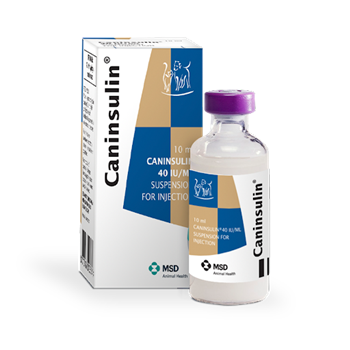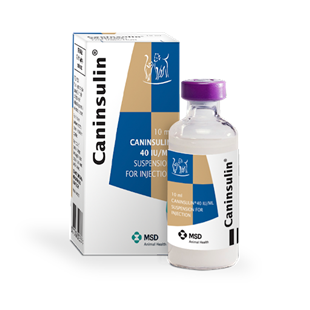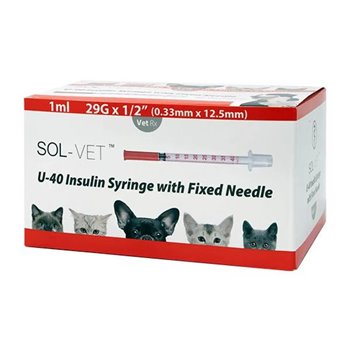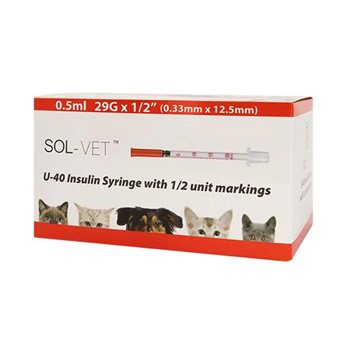
Caninsulin for Dogs Insulin Diabetes - 10ml 40u/ml
10ml Vial - Caninsulin is an intermediate acting insulin product used in cases of diabetes mellitus. VET PRESCRIPTION REQUIRED

What is Caninsulin for dogs?
Caninsulin is a form of intermediate-acting insulin that is derived from pigs. Caninsulin for dogs can be administered to dogs or cats suffering from the condition, diabetes mellitus and acts to lower blood sugar levels. Caninsulin is a POM-V category medicine that is only available with a written pet prescription from your Vet. Online pet pharmacies are only able to supply this medicine upon receipt of the prescription.
How does Caninsulin injection for dogs work?
Canine Insulin treats a condition known as diabetes mellitus. Diabetes is caused by an absolute or relative lack of insulin. This means that the pancreas may be unable to produce sufficient insulin to control blood sugar levels, or that the insulin produced in unable to have any...
What is Caninsulin for dogs?
Caninsulin is a form of intermediate-acting insulin that is derived from pigs. Caninsulin for dogs can be administered to dogs or cats suffering from the condition, diabetes mellitus and acts to lower blood sugar levels. Caninsulin is a POM-V category medicine that is only available with a written pet prescription from your Vet. Online pet pharmacies are only able to supply this medicine upon receipt of the prescription.
How does Caninsulin injection for dogs work?
Canine Insulin treats a condition known as diabetes mellitus. Diabetes is caused by an absolute or relative lack of insulin. This means that the pancreas may be unable to produce sufficient insulin to control blood sugar levels, or that the insulin produced in unable to have any effect upon the body (something known as insulin resistance). Some conditions can make an animal more likely to develop diabetes, for example, pancreatic inflammation or pancreatitis can destroy the ? islet cells within the pancreas, responsible for the production of insulin. Some conditions can cause your pet’s immune system to behave abnormally and cause destruction of the pancreatic cells responsible for insulin production.
In human medicine, when diabetes is caused by reduced insulin production from the pancreas, it is termed type 1 diabetes. In comparison, being over-weight or obese can increase the likelihood that the insulin naturally produced by the pancreas will not work properly and be ineffective – insulin resistance. This form of diabetes is termed type 2 in human patients.
High blood sugar levels cause glucose to leak into the urine and affected animals often: drink excessively, urinate excessively, lose weight, often appear hungrier, especially in the early course of the disease, become more prone to infections, e.g. urinary infections, skin infections. In circumstances where diabetes has been affecting an animal for a prolonged period of time, animals may: develop cateracts (mainly in dogs), develop neurological conditions (mainly in cats), become rapidly ill and stop eating, vomit, become lethargic and depressed or even collapse as they develop a condition known as diabetic ketoacidosis. If your pet starts showing any of these signs, it is essential that you visit your vet in order to rule out many other conditions that may have similar symptoms
What is Caninsulin used for?
The active ingredient in Caninsulin is a purified form of pig insulin, produced by the beta islet of langerhans cells, found within the pig’s pancreas. Dog Insulin triggers an anabolic state in which carbohydrates, proteins and fat is produced. Insulin allows glucose, obtained from food or by the breakdown on protein or glycogen, to be taken up into cells. Glucose is required in relatively higher quantity by the liver, brain and adipose tissue. Diabetes therefore allows glucose to reach higher levels within the blood stream. In diabetic dogs, the action of Caninsulin in blood glucose concentrations, following subcutaneous administration peaks at about 4-8 hours post-injection and lasts for 14-24 hours. In diabetic cats the action of Caninsulin on blood glucose concentrations after subcutaneous administration peaks at about 4-6 hours and lasts for 8-12 hours post-injection.
How is Caninsulin administered?
Caninsulin is given by subcutaneous injection (under the skin). Insulin must be given using the specially designated caninsulin syringes (with red caps). If different syringes are used, the dose of insulin being given to the animal will differ and could potentially cause life-threatening consequences. Caninsulin can also now be delivered using the Vet Pen that makes the process of delivering insulin to your pet simpler and more accurate. It is important that insulin is stored correctly (in the fridge at between 2-8 degrees C) and is only gently agitated (not shaken as this damages the insulin). Dog Insulin should only be given if your dog is eating normally and seems well. If your diabetic dog seems unwell, you should consult a Vet immediately.
Caninsulin is available as a white or nearly-white suspension, in 2.5ml or 10ml vials or as a vet pen.
A Veterinary Prescription is Required for Caninsulin
** PLEASE NOTE - We cannot deliver Caninsulin outside the UK as we cannot guarantee it will stay refrigerated during shipping.
Diabetes is a condition that can affect all sorts of animals, including dogs as well as people. While diabetes is slightly more common in cats than in it is dogs, it is estimated that around one in every five hundred dogs will be diagnosed with diabetes at some stage of their lives, and a diagnosis of diabetes can be very concerning for the owners of such dogs.
However, diabetes can usually be successfully managed to allow your dog to lead an otherwise healthy and happy life, and it is worth finding out more about some of the basics of the condition so that you can spot the potential symptoms, and understand the terminology that your vet will use to explain the condition to you.
Diabetes explained
Diabetes is a condition caused by irregularities of the body’s insulin levels, which are essential to break down the carbohydrates from food into glucose. Glucose is then processed in the intestine, to provide essential fuel for life. How the body’s glucose is regulated and broken down is controlled by a hormone called insulin, which is itself produced by the dog’s pancreas.
Diabetes comes in two forms: Type one and type two.
In type one diabetes, the pancreas simply does not produce enough insulin to process glucose properly, while in type two diabetes, the pancreas produces insulin, but the body is unable to sufficiently process it to regulate glucose on its own.
The symptoms of diabetes in dogs
Diabetes is very rarely asymptomatic, and usually comes accompanied by a range of symptoms and warning signals that will progressively worsen over time. These symptoms tend to come in combination with each other, and dog owners should look out for the following signs of a problem:
• Drinking a lot of water.
• Excessive urination.
• Loss of weight and condition for no obvious reason.
• Lethargy, listlessness and a loss of interest in exercise and normal play.
Diagnosing canine diabetes
If you are concerned about any of the above symptoms, it is vital to take your dog along to the vet to be checked out, as the earlier that they are diagnosed and treatment begins, the better your dog will fare in the long run.
When you take your dog along to the vet and explain their symptoms, your vet will run a couple of tests on their blood and urine, which will usually produce a definitive diagnosis in a short period of time. If your vet does confirm diabetes, they will usually begin treatment for the condition promptly, and need to see your dog several times to monitor their blood: glucose balance and work out the best form of treatment.
Living with a diabetic dog
Diabetes cannot be cured or permanently corrected, and the condition will require ongoing management for the duration of your dog’s life. Managing diabetes for the long term involves correcting the body’s insulin imbalance or lack of production, and working to minimise any side effects or other complications that can arise because of the condition.
Diabetic dogs will generally need to be prescribed a special diet, and in some cases, this alone is sufficient to keep the condition under control, along with regular monitoring of their blood: glucose levels with a special device such as the AlphaTrak 2 glucose monitoring system for use with test strips.
However, many diabetic dogs will also require the supplemental administration of insulin, which comes in the form of an injectable compound that your vet will teach you to administer to your dog at home. A special form of insulin that is designed to meet the needs of the diabetic dog, such as Caninsulin, is the usual recommendation of veterinary professionals.
Generally, diabetic dogs need to be injected twice per day when they have their meals, and you will also need to learn how to monitor your dog’s blood: glucose levels, as well as arrange regular visits to your vet to ensure that the condition is being kept under control and not having any adverse side effects on your dog.
It is also vital to keep your dog’s weight within healthy parameters, as obesity can actually lead to diabetes developing, and worsen the condition and its effects on the dog after diagnosis.
Are some breeds of dog predisposed to diabetes?
Any breed of dog can theoretically develop diabetes, but it is more common in some breeds than others. The Cairn terrier, Samoyed, Poodle and Yorkshire terrier are just four breeds that seem to have an elevated chance of developing diabetes at some point in their lives.
Diabetes is also much more common in female does than in males, with around 70% of all cases of canine diabetes being diagnosed in bitches. Certain conditions such as Cushing’s disease can also elevate the risk factors for your dog developing diabetes too, as can long term administration of certain medications such as steroids, and so such dogs much be especially carefully monitored for the early signs of the condition.



10ml Vial - Caninsulin is an intermediate acting insulin product used in cases of diabetes mellitus. VET PRESCRIPTION REQUIRED

***Please note*** These will temporarily be substituted with 30 SOL-M syringes due to a long term manufacturer's shortage, but will be identical. Syringes with needles for use with Caninsulin insulin

***Please note*** These will temporarily be substituted with SOL-M syringes due to a long term manufacturer's shortage, but will be identical. Syringes with needles for use with Caninsulin insulin